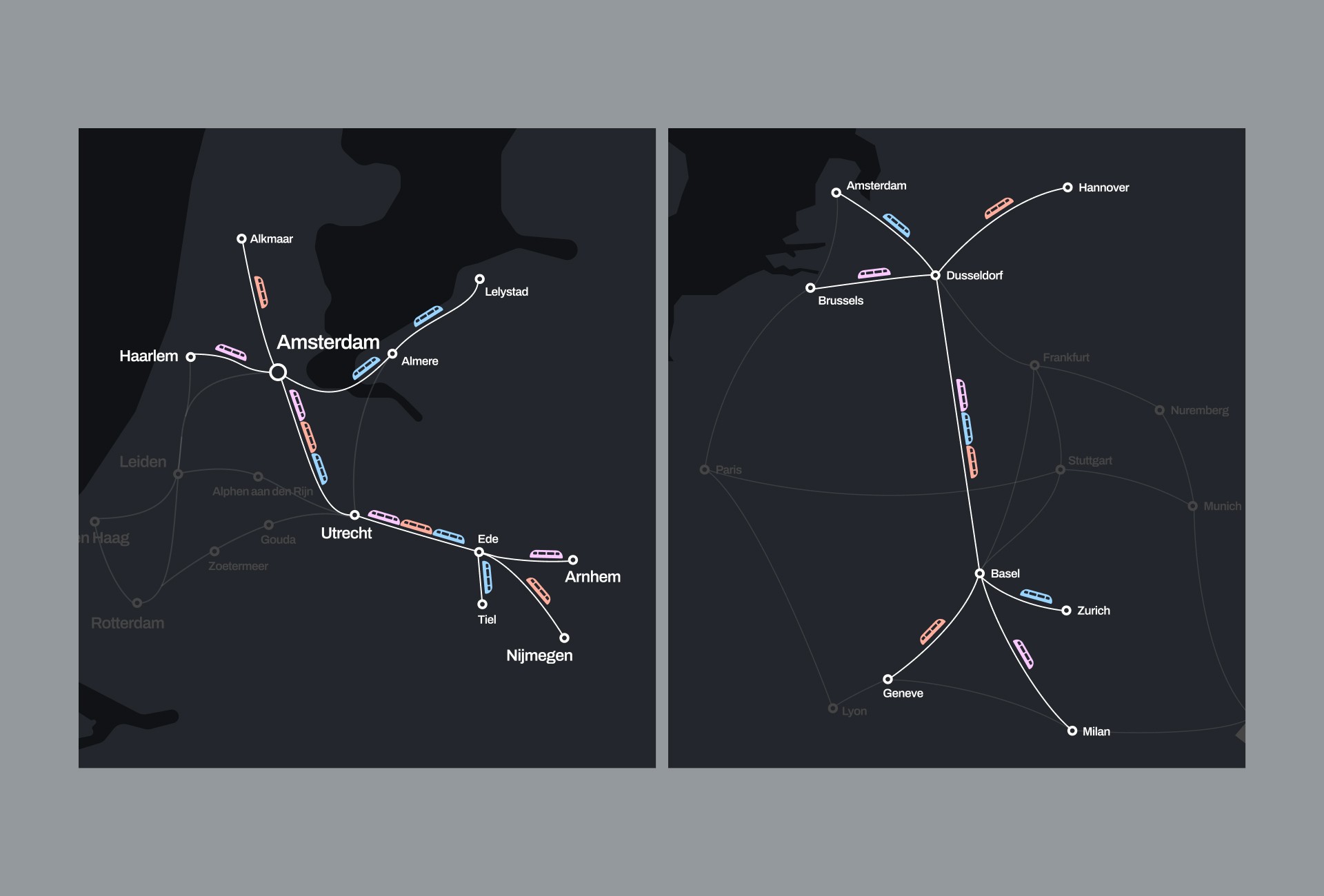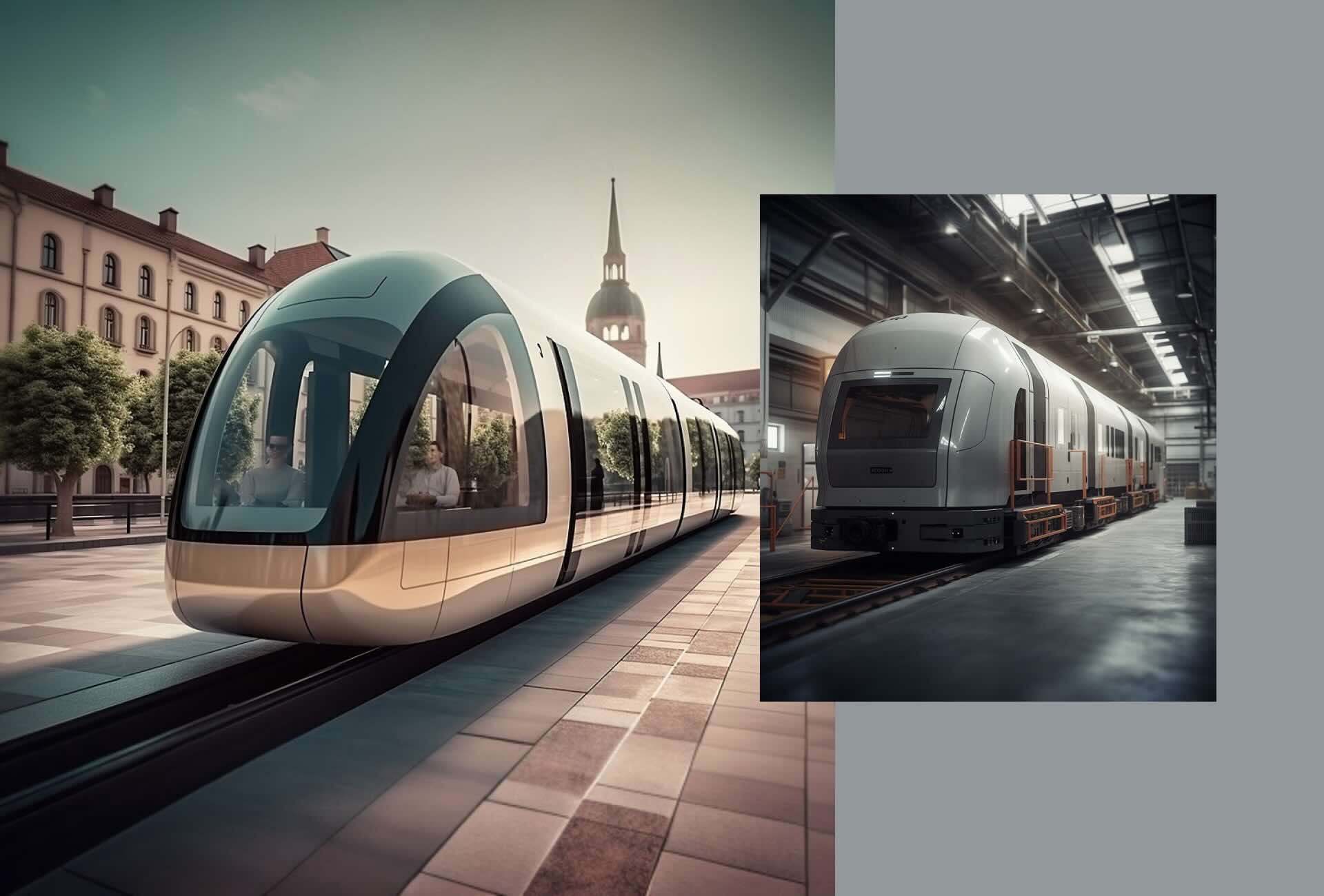Automated pooling
These individual train units could automatically pool together when travelling long distances, forming larger, more energy-efficient convoys, like regular trains. Conversely, they would uncouple as soon as the network branches out into secondary routes, or they would recouple again with other units coming from different origins but heading to the same destination.
For ease and safety, coupling and uncoupling manoeuvres would happen during stops, but it is possible to imagine a future where this could happen on the move as well, between highly precise connected trains.
The idea of trains joining and disjoining is not new. High-speed trains from Germany to France to Japan already couple together, automatically, when two trains from two different branches of the network need to join to run a common, busier stretch or rail.
End-to-end routes. Bye Hub-and-Spoke
Air transportation has seen a trend from Hub-and-Spoke frameworks (where trips flow through bigger, centralised nodes, with extra-large planes connecting the biggest nodes with each other) to distributed, Point-to-Point frameworks (where every node is connected with each other, via smaller planes). In the past, a flight from London to Palermo would have cost you a 3-hour layover in Rome (Hub-and-Spoke model); today, you will more likely find direct flights from London to Palermo, on smaller jets (Point-to-Point model).
Train transportation has not gone through a transformation as radical as the one seen in the air industry. Individual trolleys that join and disjoin automatically could deliver that transformation. Imagine moving away from a paradigm where you need to change trains, to a paradigm where each carriage of your convoy reaches a different destination — and you just board the carriage of your train that reaches your required destination. This would make train trips radically more convenient and potentially faster than regular train routes, with less (or none) train changes, meaning no risks of missed connections.
Such a system, where remote destinations could be reached by 1-carriage pods, would allow for a greater number of smaller destinations to be linked to railway, having to build smaller stations that only need to accommodate individual carriages, increasing even further the potential for end-to-end routes.
Higher frequency
Individually-powered carriages would also allow for higher train frequency, granting a traveller experience more similar to the one of an urban tram system, rather than a traditional train network. This would be especially true in more remote locations, where the pressure to couple trains together (due to line congestion and safety reasons) would be lower.
For example, a remote train station, served today by one 3-carriage-long train per hour, could instead be served by a 1-carriage-long train every 20 minutes — each of which, once again, could have a different long-distant destination, allowing for convenient point-to-point connections even from a small city.
More, smaller train stations
A dynamic train systems, based on smaller travelling units, has an important consequence: train infrastructures — train stations, train depots, cargo terminals — could become radically smaller, at a lower cost in land, design, work, and money. In turn, this would allow the creation of a greater number of stations and nodes, granting smaller cities and industrial areas a connection to the rail network, thus radically expanding the locations that can be reached by train.
Farther in the future, even larger cities could be positively impacted by the creation of a larger network of small train stations. Through the integration between urban and extra-urban mobility (for now, mostly segregated in most cities), extra-urban trains could start their journeys from a variety of stations within in a big city, before coupling together as a longer convoy to reach farther destinations. Imagine catching an inter-city train from the tram stop or the underground stop next to your house, instead of going to Central Station.
While classic rail transportation revolves around long convoys, with hub-and-spoke routes, we envision a future of rail transportation with shorter, more frequent, self-driving convoys, that can pool dynamically when needed, and with more point-to-point routes. Such a shift would also allow for more and smaller train stations, and the creation of additional lines to serve smaller cities otherwise not reached by railways.
Mixed passenger-freight use
In air transportation, mixed passenger-freight use is quite common, with as much as 45% of airfreight being transported in the belly of passenger planes. This is not quite happening in the rail industry. Even though not core in this analysis, the model of rail transportation described here could potentially impact freight transportation as well. With a larger point-to-point network, rail freight transportation could win an edge against road transportation.
Concretely, this could either work by envisioning space for freight within each passenger units (for example a storage space for 4 pallets, made available to standing passengers if unused), or by envisioning similar self-powered units.
Contextually, the EU aims to double freight rail's modal share by 2030, reducing CO2 emissions and easing congestion. The plan wants to revert the decline of rail freight over the past 70 years, with modal share decreasing from 60% in the 1950s to 15% today. The planned growth, a 6% annual growth in ton-kilometers from now till 2023, can only be achieved with significant change in course. Traditional actions would focus for example on improving long-distance cargo movements, or reinforcing crucial connection nodes like ports, but first and foremost the rail network should become more customer-centric, in order to win back customers, lost to the convenience of road point-to-point transportation.
Conclusions
Although purely speculative, this perspective on railways looks creatively at the challenges of electrification and sustainability, making the case for a shift of focus from road to rail transportation for both passengers and freight. On the path to sustainable and electric mobility, the challenge posed by the manufacturing and disposal of batteries, together with an increasingly car-less urban population, puts trains in a new spotlight — after all, they need no batteries, and they can go self-driving years before cars —, and asks from them higher standards in terms of flexibility and available routes.
We envisioned an unbundled approach to rail, where each single carriage acts as a base unit, a “mini-train”, with its own independent route, and coupling with neighbouring units only when running on the same routes. Higher pressure would be added to the network, with a higher number of swarm mini-trains moving at all time — complex, yet technically feasible, thanks to increasingly sophisticated self-driving and anti-collisions capabilities.
This vision has the potential to deliver a greater number of point-to-point routes, with less train changes, at higher frequency, serving more cities and neighbourhoods, delivering a self-driving revolution way earlier than on road, and matching the mobility expectations of car-less urban population.





